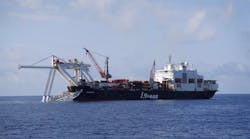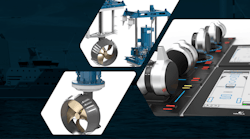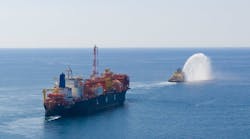Christopher Hannan
Baker Donelson
Over the last year, the US Coast Guard (USCG) has focused on normalizing the regulatory sphere on the outer continental shelf (OCS) by making a concerted effort to give industry definitive parameters.
In February, the USCG Marine Safety and Security Council released the winter issue of its quarterly magazineProceedings: Journal of Safety and Security at Sea, entitled "The Outer Continental Shelf: One Shelf, One Standard." The journal provided many insights into the long- and short-term outlook regarding the regulatory environment on the US OCS; and noted the rapid technological advances that have advanced OCS capabilities into deeper offshore waters, outstripping the scope and content of existing regulations.
In addition to the regulatory outlook set forth inProceedings, the USCG's rulemaking over the last year has exhibited the "One Shelf, One Standard" approach to regulating industry on the OCS.
The USCG issued a notice of proposed rulemaking (NPRM) to seek comment on a proposed rule that would require all "vessels engaged in OCS activities" – including both domestic- and foreign-flagged vessels – "to develop, implement, and maintain a vessel-specific [Safety and Environmental Management System (SEMS)] program that incorporates [API RP 75] . . . to be. . . compatible with a designated lease operator's SEMS required under [BSEE] regulations." (78 Fed. Reg. 55230 [Sept. 10, 2013]).
This SEMS requirement would solve the problem of BSEE-USCG overlap by rendering SEMS applicable to all vessels and facilities across the board on the OCS. This proposed USCG SEMS rule also notes that many vessels currently operating on the OCS are subject to compliance with the Safety Management System (SMS) standards of the International Safety Management (ISM) Code (as promulgated by the International Maritime Organization and applicable under USCG regulations at 33 CFR Part 96).
Thus, the USCG is seeking comments regarding whether the ISM SMS standards (or even others issued by the International Association of Drilling Contractors or International Standards Organization) could constitute as an alternative means of satisfying SEMS requirements for OCS vessels.
Likewise, the USCG has issued two calls for comments "regarding a draft policy letter on DP systems, emergency disconnect systems, blowout preventers, and related training and emergency procedures on mobile offshore drilling units (MODUs) in light of the potential for catastrophic environmental damage and loss of life in the event of a DP failure on a MODU on the OCS." (77 Fed. Reg. 26562 [May 4, 2012]).
Finally, the USCG issued an NPRM in May 2013 proposing the adoption of API RD 2 for all vessel-mounted cranes on MODUs and offshore supply vessels (OSVs), which would again solve the problem of BSEE-USCG regulatory dichotomy by simply rendering all cranes on the OCS (vessel-mount or rig-mounted) to the same standards. (78 Fed. Reg. 27913).
These recent instances in which the USCG has adopted and/or reacted to the prior edicts of BSEE are consistent with the "One Shelf, One Standard" trend. As a result, vessel operators working on the OCS need to be aware of new rulemaking by both BSEE and the USCG – and perhaps even the IMO – that may be applicable to vessel and/or vessel related operations, and should consider submitting comments in response to any NPRMs issued by both agencies as and when appropriate.
Finally, and most recently, effective Aug. 18, 2014, the USCG followed through on its promise in theProceedings winter journal and issued an interim rule setting forth comprehensive regulations for a new class of US-flagged large OSVs more than 6,000 tons. (79 Fed. Reg. 48894).
As it has done in the SEMS NPRM, the USCG looked to international standards to establish unified set of regulations for the industry on the OCS. At a high level, the new regulations set forth comprehensive standards for large OSVs "to meet safety needs by establishing design and operation standards" for this class of vessels newly available in the US domestic fleet. The USCG has adopted certain pre-existing USCG standards for smaller OSVs and other vessel types with similar attributes to these large OSVs (i.e. tanker and cargo vessels); adopted wholesale certain standards under various international conventions; and developed certain of its own hybridized regulations derived from international standards supplemented by the USCG.
The USCG notes that it "has never required OSVs to comply with international standards as a flag state in the past." In short, the interim rule seeks to establish a unitary regulatory regime for large OSVs, to avoid the prior practice (before the Coast Guard Authorization Act) of certificating what were effectively large OSVs via multiple certificates under a hodge-podge of standards that applied directly to non-OSV types (i.e. chemical and petroleum tank vessels). This interim rule will allow for a streamlined, single certification for multi-purpose OSVs.
In its continued quest for unitary standards in the ever-expanding oil patch, the USCG notes in the interim rule that it "may initiate a separate, broader rulemaking to address issues common to OSVs of all sizes."
The path forward
USCG's vision, as set forth in the "One Shelf, One Standard" issue, highlights some of the recent on-the-ground steps the USCG has taken to put this vision into practice. Other prominent regulatory issues and/or new regulatory initiatives include:
- The USCG, BSEE, and various class societies are considering changes to existing regulations to prolong the life cycle of TLP mooring systems using new technologies.
- The newly established USCG National Center of Offshore Expertise is evaluating USCG licensing standards to determine proper requirements for licensing of "ballast control officer," "barge supervisor," and "offshore installation manager."
- The USCG and BSEE continue to develop synergies in terms of their dual and sometimes overlapping spheres of regulatory authority on the OCS. For example, MODU and fixed facility oversight and information exchange; updating and revalidation of legacy USCG/BSEE agreements; and the development of a new memorandum of understanding regarding inspection responsibilities for offshore vessels that service and/or construct renewable offshore energy projects.
- The USCG is working to amend its coastal state regulations (33 CFR Subchapter N) to ensure that all MODUs, floating facilities, and vessels – both foreign-flagged and US-flagged – operating on the OCS are held to the same standards. These new regulations will "incorporate industry consensus and international standards, which will set the framework to keep pace with the rapidly evolving technology employed on the OCS."
- The USCG is considering publishing new rules to address dynamic positioning (DP) standards (pursuant to its flag state authority under Title 46), and has also initiated non-regulatory efforts to foster DP safety and gather information for a potential rule in the future.
Dove-tailing off of its discussion of the current OSV construction boom, the USCG noted that its final rules for inspection and certification of large OSVs more than 6,000 tons would be published in the near term to give effect to the 2010 Coast Guard Authorization Act, which removed the prior statutory bar prohibiting US-flagged OSVs more than 6,000 gross tons.




